COLOR KEY
RED TEXT = Félicia Atkinson quotes from Tiny Mix Tapes interview
ORANGE TEXT = Félicia Atkinson quotes from A Closer Listen interview
GREEN TEXT = Félicia Atkinson quotes from self-titled mag interview
Underlines in etymological definitions my own.
+
“I paint the way I do because I’m just plain scared. I mean, I think it’s a scream that we’re alive at all, don’t you?” –Gertrude Abercrombie
“Painting is a source of everyday joy for me.” –Félicia Atkinson
+
Imagining Félicia Atkinson. Her imaginary music. Is all music imaginary? No, but this is.
Magical. “It’s not exactly realistic, all the elements are realistic but they’re put together in a way that makes them something way beyond realism,” writes Susan Weininger on the work of American magical realist painter Gertrude Abercrombie.
It’s good not to know everything — magical, mystery.
Textures of etymology. Many poets that have, at one time or another, been very important to me, such as Susan Howe, Harryette Mullen, Jena Osman, and Gertrude Stein have written toward direct or abstract relationships with the study. Howe and Osman drop definitions into their works like little treats and chew on them until they are stuck deep in their teeth. Mullen and Stein frequently tease the idea of definition, and, when exercised, its disorienting music as their practice.
The Flower and the Vessel is etymological in the magical realist sense. It traces language as a memory. As TRACE language. Trances.
+
vessel (n.), c. 1300, “container,” from Old French vessel “container, receptacle, barrel; ship” (12c., Modern French vaisseau) from Late Latin vascellum “small vase or urn,” also “a ship,” alteration of Latin vasculum, diminutive of vas “vessel.” Sense of “ship, boat” is found in English from early 14c. “The association between hollow utensils and boats appears in all languages” [Weekley]. Meaning “canal or duct of the body” (especially for carrying blood) is attested from late 14c.
When thinking about vessels, my mind drifts to the work of a friend, Sammie Anselmo. She creates luscious ceramic wares such as plates, goblets, decanters, and urns that could easily function as bird baths and punch bowls. Her work seems to have been formed from mud found in the garden, decorated with flowers, weeds, vines, twigs, pebbles, and live insects, colored-in with the juice from smashed berries and smooshed grass, fired in the earth’s warm belly and glazed by rain.
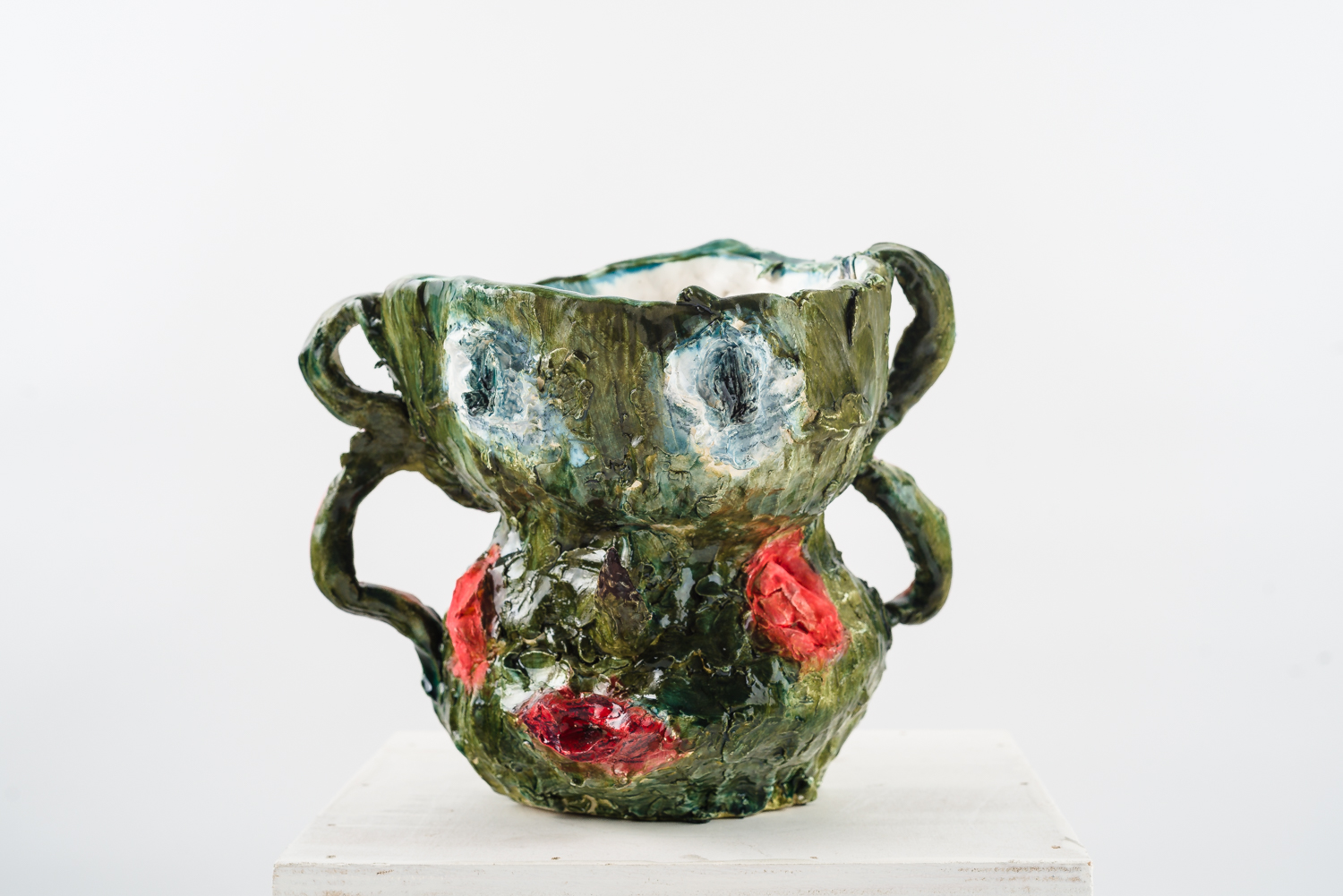
I never follow recipes, neither in the kitchen, nor in the studio.
Sammie’s are fine artworks to be engaged with rather than fixed into place, just like this music. Her pieces seem to merge the practical (items for daily use) with the whimsical (fairy tale scenes) to become receptacles for magical experiences. They emerge from a voracious mind and tender heart to imagine the world in a similar way to Atkinson’s sounds and Abercrombie’s figures: fantastically. And, too, across all of their works, there is something slightly impish lingering under the surface. A cup might bite at your tongue as you sip. A trail through the woods is suddenly swallowed up by grass. A voice burrows into your ear, although no one is there to speak it.
+
“Everything is autobiographical in a sense but kind of dreamy. It’s way off in the skies.” –Abercrombie
Right now, I make most of my money by working as a nanny. As I write this, I am away from my home working as an au pair for three children in a New England country town. I am in a room that is not my own. I walk around the fields and pick wildflowers to place in glass jars by my bedside. Black-Eyed Susans. Russian Sage. Something that smells like honeysuckle for which I can’t find a name.
flower (n.) c. 1200, flour, also flur, flor, floer, floyer, flowre, “the blossom of a plant; a flowering plant,” from Old French flor “flower, blossom; heyday, prime; fine flour; elite; innocence, virginity” (12c., Modern French fleur), from Latin florem (nominative flos) “flower” (source of Italian fiore, Spanish flor), from PIE root *bhel- (3) “to thrive, bloom.”
From late 14c. in English as “blossoming time,” also, figuratively, “prime of life, height of one’s glory or prosperity, state of anything that may be likened to the flowering state of a plant.” As “the best, the most excellent; the best of its class or kind; embodiment of an ideal,” early 13c. (of persons, mid-13c. of things); for example, flour of milk “cream” (early 14c.); especially “wheatmeal after bran and other coarse elements have been removed, the best part of wheat” (mid-13c.). Modern spelling and full differentiation from flour (n.) is from late 14c.
Flowers in the room feel like friends. I feel totally open with them, as I concurrently want to close off certain parts of myself to everybody else here. One of my employer’s friends told me that I have the temperament of someone in a cocoon. The room contains me and senses my containment. It carries me and knows me, intimately, although it is a room I hope to never see again. I’m transitory. I am an image that will fade from the children’s eyelids when I leave. I am a blip and a pre-memory. I am extra-sensory. I am representational and unknown.
Every day, I drive them around in a very round car. I worry about my own life behind the wheel and theirs that I am responsible for. They are little flowers with very fragile petals and stems and the vessel is strong, but crazing. Am I the vessel or is the car? I worry about the future when I leave here, both for what I know that it does and does not hold. I worry a bit less when I am alone. I worry a bit less in the landscape. I definitely worry less when I am alone in the landscape.
Let’s imagine music writing as a landscape composition.
I am a bit scared of this review.
+
“The best, the most excellent; the best of its class or kind.”
Most major music sites, as well as outlets like Artforum and NPR, have written about this album and articulated its value. Many critics have quoted Shelter Press’s accompanying text to draw roots down into their views. While it makes sense for me to do that, too, I’m hesitant, perhaps because this record has already been maximally written and its context and concepts frequently quoted.
This sweeping praise from interrelated but disparate media sources speaks to the way that this work translates across lines of style, genre, and medium. Critics, poets, fine artists, and all sorts of music people love it, and it’s funny how Atkinson actually holds all of those titles at once. I wonder, though, how do we resist albums being overwritten, and is this a problem or only a problem for me? Not literally (the more coverage the better), but gesturally?
As I write, I repeatedly think, “Don’t write ‘whisper,’ ‘hush,’ ‘quiet.’ Don’t write ‘minimal,’ ‘ambient,’ ‘unsettling.’ Don’t write ‘pregnancy,’ ‘murmur,’ ‘poem.’ Don’t write ‘Sunn O))),’ ‘piano,’ ‘ikebana.’” Not because these words are not entirely relevant, but because they have already been written or spoken by other critics or by Atkinson herself.
I wonder, is there still space to tell tales? Is there space to discuss what’s not there (imaginary, fantasy)?
What is around me? What is missing? What is too obvious? Who/what should I call? Where should I go? To whom am I connecting, referring, in order to say/show/make what I feel/want? I feel full of questions. I need to share those questions sometimes and take the risk to make some hypothesis. It’s part of the game. Share your ideas and the risk to be wrong or boring.
I am trying to take that risk. I am interested in other forms of relation. What other words and images can be used and what wildflowers might crop up, like third landscapes, in the cracks between them?
+
I enjoy very much the paintings of Peter Doig and this [the track “L’Enfant et le Pouple”] is an imaginary painting of him… I made a song that was a dream of painting.
Lately, I have been looking at Abercrombie’s paintings. I do not remember how I found her work. That trail was probably taken during a trance. I have kept the “Gertrude Abercrombie” Google Image search up on my computer for weeks and click into the tab almost every time I sit down at it.
I read, Let’s imagine a song in a shape of a door of a secret land.
I freak.
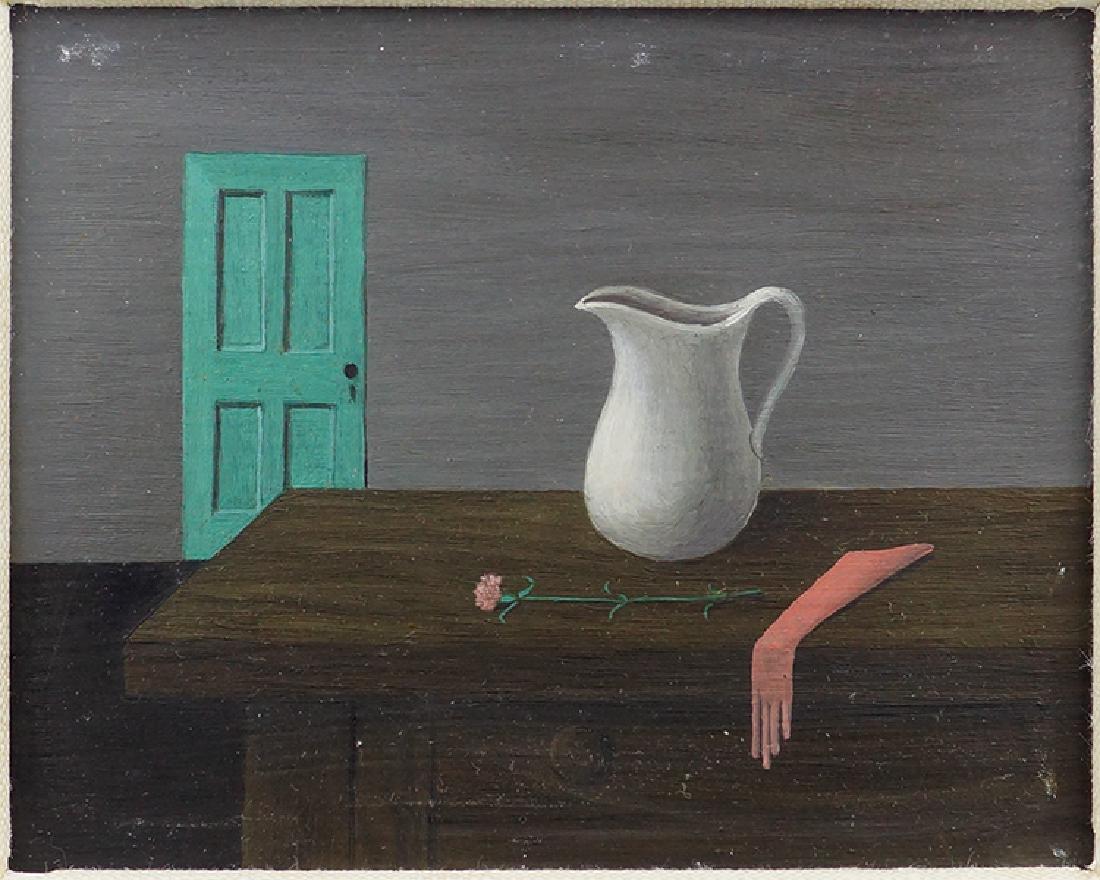
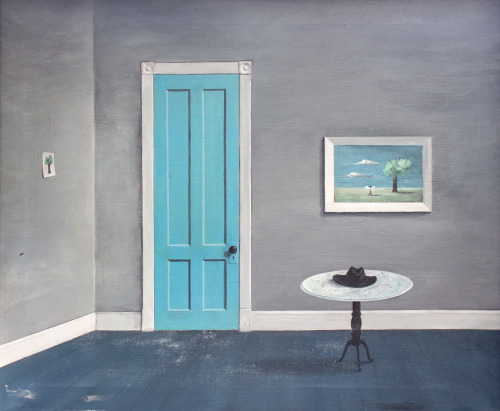


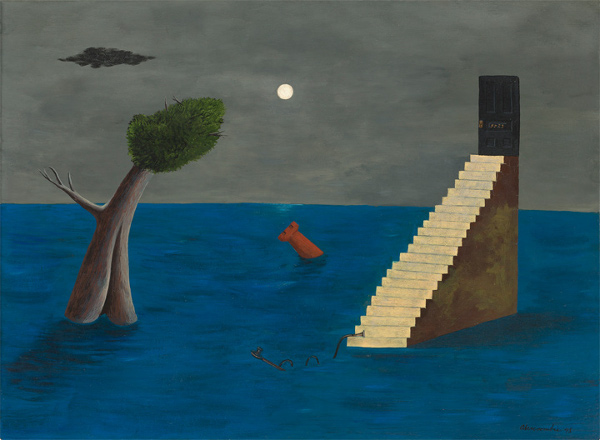

Abercrombie also made many paintings of flowers in vessels. Here is one:
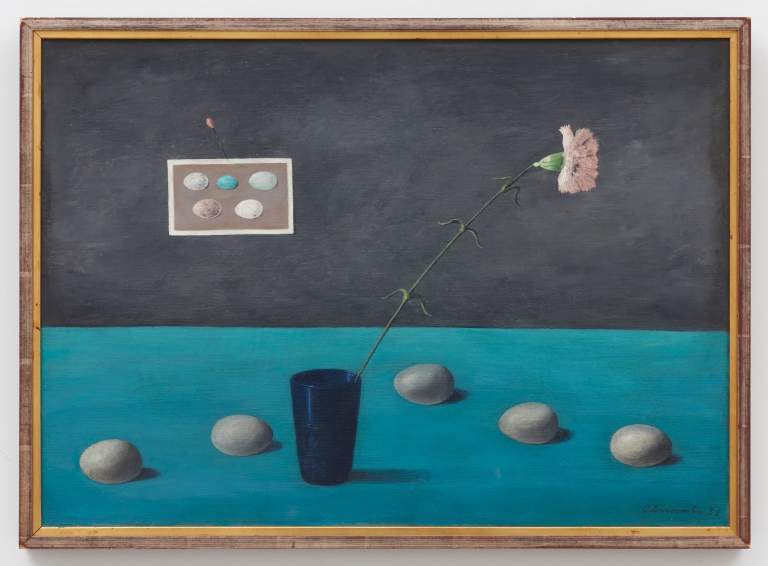
I have been meaning to read Clarice Lispector’s story “The Egg and the Chicken” for weeks. This URL has been sitting in my tabs alongside Abercrombie. Relative to the above image it seems like a good time to do it.
I read. Lispector writes:
The egg is something in suspense. It has never settled. When it comes to rest, it is not the egg that has come to rest. A surface has formed beneath the egg. I vaguely glace at the egg in the kitchen in order not to break it. I take the greatest care not to understand it. It cannot be understood and I know that if I were to understand the egg, it could only be in error. To understand is proof of error. Never to think about the egg is one way of having seen it. Could it be that I know about the egg? Of course, I know about it. Like this: I exist therefore I know. What I do not know about the egg is what really matters. What I do not know about the egg gives me the egg itself. The Moon is inhabited by eggs…
Sub the word “egg” for “album.”
An egg is a vessel.
Vessels are also things contained.
I imagine her cooking an egg and eating it off of one of Sammie’s plates.
There are so many other quotes that I want to take from this story to read against Atkinson’s music. I wonder, will you read this story and recognize them?
+
At last, I risk-think that these two artworks, Abercrombie’s Lady on a Couch (1942, oil on panel) and the cover for Atkinson’s 2017 record Hand in Hand (Shelter Press), are in conversation.
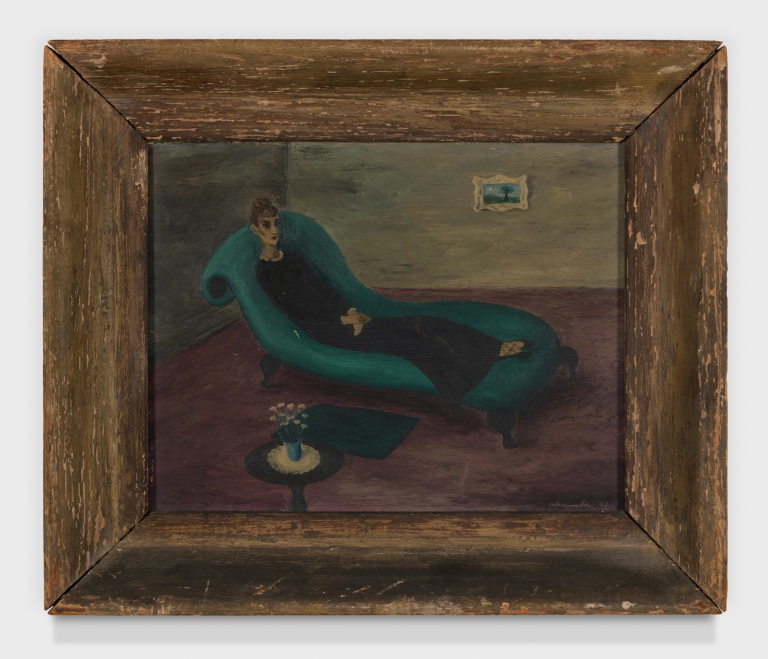

Two upside-down A’s and two swipes of green.
FA + GA. They are one step apart in the alphabet and on my keyboard.
A + A, like A to A, like “Shirley to Shirley.”
+
I spent many weeks just looking at the images in this Google search before finally feeling ready to read up on Abercrombie. The quotes that follow, like the other Abercrombie quotes I’ve used, are taken from interviews and profiles found in the book Gertrude Abercrombie (Karma, 2018).
“I am not interested in complicated things nor in the commonplace. I like and like to paint simple things that are a little strange. My work comes directly from my inner consciousness and it must come easily. It is a process of selection and reduction.”
I know why I am attracted to and affected by Abercrombie’s paintings, but at the moment, I’m unable to explain why. The effect is not translating to the words that I know. So, I hinge on theirs.
Language is an obstacle to fascination. It brings doubt and subjectivity.
“I am a pretty realistic person but don’t like all I see. So I dream that it is changed. Then I change it to the way I want it. It is almost always pretty real. Only mystery and fantasy have been added. All foolishness has been taken out. It becomes my own dream.”
I like what I see, because I really don’t like what I see.
In his essay “The Sorceress in the Center of Everything,” Robert Cozzolino wonderfully explains how Abercrombie “saw magical undercurrents in the juxtaposition of real things with their painted simulacra,” which makes me think of Atkinson’s work. The juxtaposition of lived experiences with their recorded simulacra. A magical exchange.
Abercrombie called herself a witch because many others did. She was interested in the occult, and its symbols come up again and again in her work. She said, “Sometimes I paint things and then they turn up in real life.” This feels like craft. Manifestation or creation? It sounds, again, like Atkinson is operating from similar logic, this time in reverse from the last.
Abercrombie repeats doors, cats, rooms. Sammie repeats butterflies, plants, shapes. Atkinson repeats effects, affects, tones. Lispector includes the word “egg” in her story more times than I have the patience to count. Each instance of the thing repeated is in dialogue with every other instance, and no two instances are at all alike.
+
I don’t really want to end this review. It doesn’t feel like I’m working toward a conclusion. But, at some moment, you need to put yourself at risk again and say, “I’m going to share this draft because I am bored with finished products.”
Along those lines, I have an idea to release this as an unedited collection of notes in no order. I’d leave the words and images fixed into the usually random place where I plopped them into the Google Doc where I’m composing. I don’t do it, though, because that method speaks too directly to the investment of time I have made in this writing, and I can’t get it out of my head that the voice is a vessel and time is a flower.
I realize I am attempting to write a kind of vessel. I am not attempting to write a flower.
I am attempting to create a landscape.
More about: Félicia Atkinson




